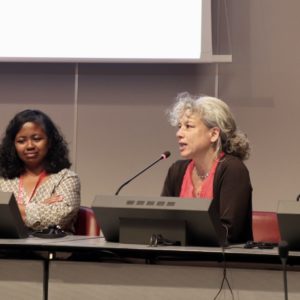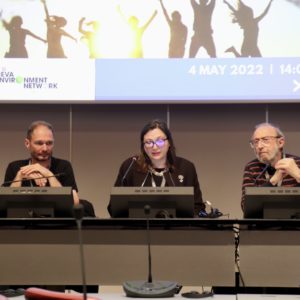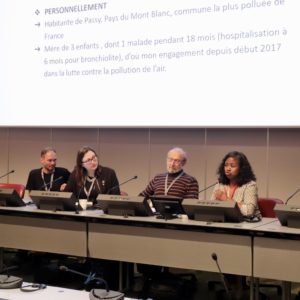Event Conference
Nothing will happen without communities: The role of NGOs in strengthening environmental health | GHF2022

This session of the Geneva Health Forum was organized with the support of the Geneva Environment Network.
Geneva Health Forum
The Geneva Health Forum gathered from 3 to 5 May 2022 to tackle crucial issues linked to health such as pollution, climate change, how to operationalize concepts such as “One Health” or “Planetary Health”, environmental drivers for pandemics, antibiotic resistance, and many more.
About this Session
Environmental degradation is having an increasing impact on human health. Although scientific evidence is accumulating and awareness is growing in society, the necessary changes are slow in coming.
Civil society is not standing still and many old and new associations are making their voices heard and taking concrete action. Like the activists who made progress in the fight against HIV in the 1990s, the movement could come from the communities themselves.
This session highlighted the role of 5 organizations, each of which in its own way has decided to take action.
Speakers
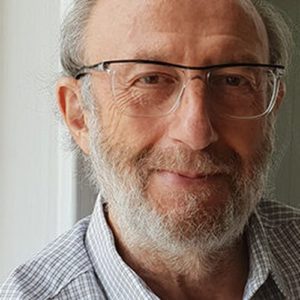
André Cicolella
Cofounder and President, Réseau Environnement Santé
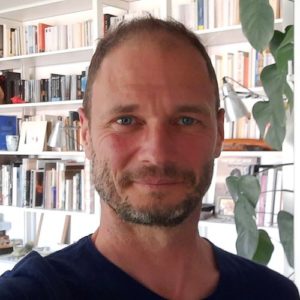
Philippe Chamaret
Director, Institut ecocitoyen
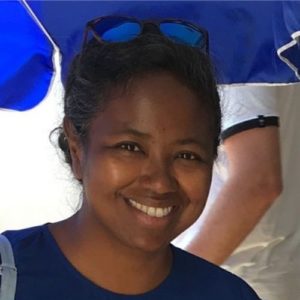
Mallory Guyon
Spokesperson, Collectif Coll’Air Pur Santé de la vallée de l’Arve
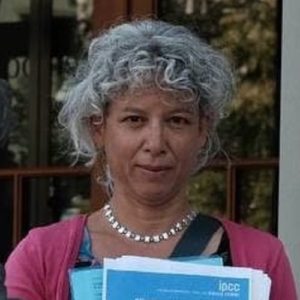
Sonja Hediger
Doctor, Doctors for Extinction Rebellion
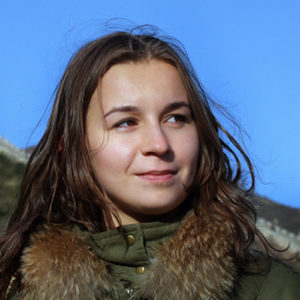
Olena Zotova
President, Réseau d’action pour la santé durable du Québec
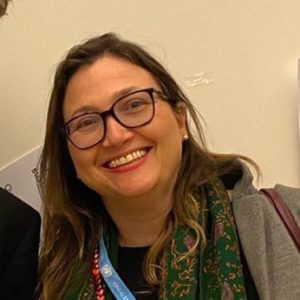
Diana Rizzolio
Coordinator, Geneva Environment Network
Summary
This event was conducted in French. Parts of this summary are English translations from French.
Diana Rizzolio | Coordinator
As the Secretary General of the United Nations and my colleagues keep repeating, our planet is facing a triple crisis of climate change, biodiversity loss and pollution. All of these crises impact our health. While scientific evidence is mounting and awareness is emerging in society, the necessary changes are slow to take place.
Panels such as the IPCC – International Panel on Climate Change (headquartered in Geneva), but also the IPBES for biodiversity are of key importance in this context. In addition, the United Nations Environment Assembly has recently decided to set up a scientific panel of expertise for issues related to chemicals, waste and pollution.
Experts are giving us scientific evidence of the environmental crises we face, with scenarios of what lies ahead. But the implementation of governance measures to avoid or mitigate these crises is often slow, as we see in the field of climate, for which the IPCC has existed for more than 30 years.
The panel members today are sort of heroes who mobilize their communities to ensure that actions are taken by the authorities to prevent these crises that have significant impacts on our health. So we are in the environmental action, because the attacks on our environment have unacceptable impacts on our health. We have communities that are mobilizing for the authorities to act and develop essential regulations.
André Cicolella | Cofounder and President, Réseau Environnement Santé
The Réseau Environment Santé (RES) was created about fifteen years ago to promote environmental health. Its first campaign in 2009 aimed at banning baby bottles containing Bisphenol A, an example that demonstrates the urgent need for a policy on environmental health. Bisphenol A is an endocrine disruptor, that is to say a chemical substance that acts on the hormonal balance thus generating increased health risks. This campaign met with great success with the banning of the marketing of these baby bottles by the French Senate in March 2010, then by the European Union in November of the same year.
Exposure to endocrine disruptors during the fetal period is crucial for the health of the child, and therefore for future generations. A paradigm shift in endocrine disruptors is therefore essential; it is urgent. It is in this perspective that we succeeded in obtaining a unanimous vote of the French deputies and senators to ban Bisphenol A also in food containers. This experience shows that it is quite possible to convince political decision makers.
The RES subsequently led several other campaigns:
- The banning of perchloroethylene in dry cleaners in France. Perchlorethylene is a toxic substance that is an endocrine disruptor, whose harmful effects on workers, local populations and the environment have been proven. This substance will be banned in France by 2023, and replaced by water-based processes.
- The Stratégie Nationale Perturbateurs Endocriniens, adopted in 2014 and marking a recognition of the paradigm shift in this area with the goal of reducing population exposure. This strategy is important, as the problem cannot be solved by addressing one chemical at a time.
- The Charte d’engagement des Villes et Territoires sans Perturbateurs Endocriniens, a campaign to protect the population and ecosystems from exposure to these toxic substances. This charter aims to eliminate endocrine disruptors in pesticides and food, as well as in all public contracts and purchases, and promotes transparent communication with communities.
- The signal that the RES had launched in 2009 has expanded and we now have a strong political decision, notably in the European Parliament, which aims to eliminate 2000 toxic substances by 2030.
- Operation Zero Phthalates, a substance commonly found in plastics, cosmetics and ultra-processed food. Exposure to phthalates during pregnancy increases the risk of childhood diseases. This project aims to make this invisible pollution visible.
- Call from Grenoble for an “IPCC” of environmental health; launched by the Collectif InterAssociatif pour la Santé Environnementale. We need to synthesize scientific knowledge to inform political decisions. If we want to tackle the health crisis in which we find ourselves and the risks of future health crises, we need a global vision.
Philippe Chamaret | Director, Institut écocitoyen
Fos-sur-Mer is a French industrial city that hosts a 10,000 hectare industrial and port area, one of the largest in Europe. Fos is home to heavy industries, which are highly emitting and diverse (refining, steel industry, logistics and transport, waste, and energy storage). All of these pollutant emissions cause the local population to be exposed to a wide variety of toxic substances in an intense manner. It is a mixture of pollutants whose precise effect on health is not known.
During construction and in the 1970s, there was no public outcry. Indeed, the whole population worked or was dependent on the industries. But in the 1980s and 1990s, massive retirements and a period of unemployment led to the emergence of a population that knew the industry but no longer worked in it.
At that time, the city of Marseille decided to install its waste incinerator in Fos, an event that crystallized the mobilization of citizens. People finally asked themselves about the effects of industrial activity on health, only to discover to their surprise that they did not know. The knowledge stopped at the strict necessary to follow the regulatory limits, and thus did not allow to really evaluate the risks on health.
Indeed, there is a huge difference between the regulatory limits and the reality of the territory, i.e. the effects of pollutants on the population. This difference meant that the authorities were unable to answer the questions of the population, which then rose up against the construction of the incinerator. The authorities responded by developing a scientific policy of territory, whose principle is to develop knowledge to support the decision. The Institut écocitoyen aims to make the link between precise scientific knowledge and the decisions that will be taken afterwards. It follows three fundamental principles:
- Study all environments in the same research (soil, air, marine systems, health, etc.). This makes it possible to go beyond the existing disciplinary silos in research.
- Systematically link environment and health
- Involve citizens in the development of knowledge
Mallory Guyon | Spokesperson, Collectif Coll’Air Pur Santé de la vallée de l’Arve
Mallory Guyon is a general practitioner and an early childhood doctor. She decided to get involved in the field of environmental health after being confronted with a paradox: the population is suffocating in the mountains, in the country of Mont Blanc. Air pollution was a taboo subject in the Vallée de l’Arve, because it disturbs tourism and the local economy.
However, the pollution is real and visible all year round, due to the gateway traffic, international truck traffic, screw-cutting factories, incinerators, a carbon graphite factory, the problem of wood heating in winter and a high population density. Passy is the most polluted commune in France. After her 6-month-old child was sick with bronchiolitis for 18 months, Mallory Guyon realized that the air was polluted. A local doctor launched the alert and citizen demonstrations were organized. In 2017, the EQIS study in 2017 reported 85 premature deaths related to air pollution in the Vallée de l’Arve.
The citizen’s collective Coll’Air Pur Santé is mobilizing to alter the population and to advance the policies on the subject. The collective became known thanks to the local media, which published their self-financed environmental study on the abnormal quantity of heavy metals in the air. The goal was to push the local elected officials to act in order to recover a breathable air, the happiness of our mountains and the health of all. The collective carried out several environmental analyses, all with frightening results, and called on the prefecture. It also launched legal proceedings with 540 complaints against X and more than a dozen medical files. In one of them, the State was recognized as being at fault, but was not condemned.
The collective also organizes air and climate marches and is very active on social networks and in the local media. Other actions take place to set an example and motivate people to follow the policy. The collective has forged links with the Association Locale pour la Qualité de Vie à Passy and has also created a departmental medical collective, the Collectif Environnement 74. The latter aims to train health professionals, educate the population and push the politicians of the department to take strong actions for health and environment. At the national level, the collective is engaged with other associations in order to popularize science and to organize national actions. In particular, it participates in the Grenoble call for an IPCC on environmental health. Finally, it aims to create the Institut écocitoyen of Mont Blanc, in order to support research and mobilize elected officials.
“Eco-citizenship mobilization must be strong. We are all heroes; you can change the world, health and the environment. We just need to get started. In four years, we have been able to make air pollution no longer a taboo. Now we can talk about it and ask questions. Everyone is involved because it is a health emergency for our children and our mountains. It is thanks to the citizens and their pressure that we will be able to change political decisions to have breathable air and good health for all.”
Sonja Hediger | Doctor, Doctors for Extinction Rebellion
The Extinction Rebellion (XR) movement is based on three claims: (1) declaring a climate emergency and really informing the population about the climate crisis, (2) achieving zero emissions by 2025, and (3) setting up citizen assemblies with decision-making power. It is also a movement that has principles and values, which speak of taking care of oneself in order to allow the care of others and the care of the planet.
The means chosen by XR to achieve its goals is civil disobedience. Through this, the movement has been able to gain media attention. At the beginning in 2019, the movement was considered as terrorists. However, the population and politicians now realize that we need people who wake up and tell the truth. The actions of XR are always non-violent, especially in relation to the violence that is being done to our planet.
The XR movement has many caregivers and so Doctors 4 XR was formed in late 2019. This new group held a conference at the Centre Hospitalier Universitaire Vaudois (CHUV) with quality speakers who highlighted the urgency of the situation and the need to get involved. This conference touched many people. Sixty caregivers agreed to disobey during an action a few days later to denounce the government’s inaction.
The population and elected officials must realize that there is a close link between environmental destruction, pollution and health. Currently, this link is not made. This is why Doctors 4 XR led an action in front of the World Health Organization (WHO). First gathered at the Place des Nations, the group then delivered a message to all health ministers gathered at the World Health Assembly. For this big action with more than 200 professionals present, the media coverage in Switzerland was very low.
The movement continues to build links with other networks and its participants will continue to be on the streets, because it is necessary. Many of them are engaged either politically, but also in resilience, in another vision of the health system, in teaching people how to take care of themselves and the planet at the same time.
Olena Zotova | President, Réseau d’action pour la santé durable du Québec
The Réseau d’Action pour la Santé Durable du Québec (RASDQ), like the other examples presented in this panel, aims to mobilize the population to act on the environment-health pole. This action network is sponsored by the Association pour la Santé Publique du Québec and the Ministère des Relations Internationales du Québec. These two actors are committed to the achievement of sustainable health in the region and beyond.
The RASDQ was built on a proven academic literature on how caregivers can mobilize communities based on personal experiences and stories. This network is based on interdisciplinary leadership, giving all people in the health sector a voice to support and achieve the goals of the movement. The mission of the RASDQ is to preserve sustainable health and environmental sustainability in Quebec. The overall objective is to mobilize the health and social services actors of Quebec in a sustainable and strategic manner around this mission.
The RASDQ brings together 20 health and social services organizations, representing approximately 1500 people. The shared governance structure of the RASDQ is based on a round table of member organizations. The RASDQ is inspired by the WHO’s social accountability framework developed in the late 1990s. This framework emphasizes the need to connect health professionals, academic institutions, communities, health administrators and policy makers to create a platform where people can communicate their needs and collaborate to create a health care system based on people’s needs.
Together, these actors are acting on a common agenda, developed under a Charter for Sustainable Health in Quebec, which itself rests on three main pillars: (1) limiting climate change, (2) supporting sustainable communities, and (3) developing a sustainable, carbon-neutral health system.
The RASDQ has tabled a petition for a carbon neutral health system in Quebec in the National Assembly. In addition, several opinion campaigns and other resources were published in various media. Capacity building and trainings were developed in terms of local projects and climate action. Collaboration in the health care sector was developed with the goal of breaking down existing silos between disciplines and creating a platform to break them down. By building a movement, the RASDQ has been able to garner support from traditionally more conservative entities in the health system, which has increased the ambition of the health system.
Given the goal of producing positive social change, RASDQ is receptive to learning best practices from other experiences and following the collective impact model. RASDQ aims to overcome the challenges of limited resources and funding and, more importantly, to engage more persistently with policy makers and institutions. In this sense, funds are not only needed to finance large projects, but also community collaborations and connections between organizations that have the power to create social change and more sustainable societal structures.
Q&A
Q: What are the challenges and strategies for mobilizing communities? And what about the gender dimension? It seems that many women are involved in environmental health advocacy in citizen movements, but far fewer in decision-making processes.
André Cicolella: What these organizations have in common is the effort to highlight the different links between health and the environment, because we are constantly learning about new forms of invisible pollution for example. So the role of NGOs is to make invisible pollution visible. On the other hand, many of the measures taken to reduce health risks and pollution are actually the main causes of it. There is a need for more and more consistent science-based measures. Rural communities are just as affected, or in some cases worse, by invisible pollutants and pesticides. They are indeed involved in our action through the engagement of local authorities and actors, who have an impressive level of awareness of the risks and impacts of environmental factors on their health because they have a closer relationship with citizens. We mainly adopt two strategies to integrate local level actors. First, by integrating the environmental associations that have been working on these issues. Second, to integrate a larger part of the population, we included them in the research process to identify environmental solutions. The place where we work is quite rural and characterized by a strong attachment of people to the environment in which they live.
Mallory Guyon: Our mobilization takes place in a mountain region that lives on tourism, so it was very difficult to act. What made the difference was the composition of our all-female committee, brought together by fear of the impact on children’s health. The initial reaction from the justice system was less than positive, calling us “hysterical”, but our persistence and strategy to exploit the media paid off. The fact remains that the scientific evidence needs to be completed, which requires broad public participation.
Q: Today’s panel is composed only of organizations from the North, while countries in the South are very much affected by environmental impacts. How do your organizations involve or intend to involve Southern organizations and actors on this issue in the future?
Diana Rizzolio: The composition of the panel is related to the choice of organizing this event in person, which makes it more difficult for people from the global South to attend, especially due to COVID restrictions. GEN always ensures that the composition of its events is balanced in terms of gender and geographic region.
Sonja Hediger: The Doctors for Extinction Rebellion is a very international movement; it relies on mobilization tools that are shared around the world.
Video
The session was streamed live on YouTube. This video features the interpretation in English from French. The original version in French can be listened here.



